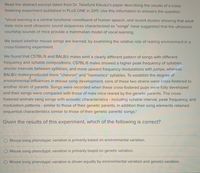
Human Anatomy & Physiology (11th Edition)
11th Edition
ISBN: 9780134580999
Author: Elaine N. Marieb, Katja N. Hoehn
Publisher: PEARSON
expand_more
expand_more
format_list_bulleted
Question
Please solve

Transcribed Image Text:Read the abstract excerpt taken from Dr. Takefumi Kikusui's paper describing the results of a cross
fostering experiment published in PLOS ONE in 2011. Use this information to answers the question.
"Vocal learning is a central functional constituent of human speech, and recent studies showing that adult
male mice emit ultrasonic sound sequences characterized as "songs" have suggested that the ultrasonic
courtship sounds of mice provide a mammalian model of vocal learning.
We tested whether mouse songs are learned, by examining the relative role of rearing environment in a
cross-fostering experiment.
We found that C57BL/6 and BALB/c males emit a clearly different pattern of songs with different
frequency and syllable compositions; C57BL/6 males showed a higher peak frequency of syllables,
shorter intervals between syllables, and more upward frequency modulations with jumps, whereas
BALB/c malesproduced more "chevron" and “harmonics" syllables. To establish the degree of
environmental influences in mouse song development, sons of these two strains were cross-fostered to
another strain of parents. Songs were recorded when these cross-fostered pups were fully developed
and their songs were compared with those of male mice reared by the genetic parents. The cross-
fostered animals sang songs with acoustic characteristics - including syllable interval, peak frequency, and
modulation patterns - similar to those of their genetic parents. In addition their song elements retained
sequential characteristics similar to those of their genetic parents' songs."
Given the results of this experiment, which of the following is correct?
Mouse song phenotypic variation is primarily based on environmental variation.
Mouse song phenotypic variation is primarily based on genetic variation.
Mouse song phenotypic variation is driven equally by environmental variation and genetic variation.
Expert Solution
This question has been solved!
Explore an expertly crafted, step-by-step solution for a thorough understanding of key concepts.
This is a popular solution
Trending nowThis is a popular solution!
Step by stepSolved in 2 steps

Knowledge Booster
Learn more about
Need a deep-dive on the concept behind this application? Look no further. Learn more about this topic, biology and related others by exploring similar questions and additional content below.Similar questions
- help please !!!!!!! thank you in advancearrow_forwardKEY: Hydrophobic interactions: Salt bridge: Covalent bonds: Hydrogen bonding: Metal ion coordination: 9. 10What components of the plasma membrane might you drug interact with? Explain can use as many components as you need (may need more or less). Component 1 and why: Component 2 and why: Component 3 and why:arrow_forwardPlease answer very soonarrow_forward
arrow_back_ios
arrow_forward_ios
Recommended textbooks for you
 Human Anatomy & Physiology (11th Edition)BiologyISBN:9780134580999Author:Elaine N. Marieb, Katja N. HoehnPublisher:PEARSON
Human Anatomy & Physiology (11th Edition)BiologyISBN:9780134580999Author:Elaine N. Marieb, Katja N. HoehnPublisher:PEARSON Biology 2eBiologyISBN:9781947172517Author:Matthew Douglas, Jung Choi, Mary Ann ClarkPublisher:OpenStax
Biology 2eBiologyISBN:9781947172517Author:Matthew Douglas, Jung Choi, Mary Ann ClarkPublisher:OpenStax Anatomy & PhysiologyBiologyISBN:9781259398629Author:McKinley, Michael P., O'loughlin, Valerie Dean, Bidle, Theresa StouterPublisher:Mcgraw Hill Education,
Anatomy & PhysiologyBiologyISBN:9781259398629Author:McKinley, Michael P., O'loughlin, Valerie Dean, Bidle, Theresa StouterPublisher:Mcgraw Hill Education, Molecular Biology of the Cell (Sixth Edition)BiologyISBN:9780815344322Author:Bruce Alberts, Alexander D. Johnson, Julian Lewis, David Morgan, Martin Raff, Keith Roberts, Peter WalterPublisher:W. W. Norton & Company
Molecular Biology of the Cell (Sixth Edition)BiologyISBN:9780815344322Author:Bruce Alberts, Alexander D. Johnson, Julian Lewis, David Morgan, Martin Raff, Keith Roberts, Peter WalterPublisher:W. W. Norton & Company Laboratory Manual For Human Anatomy & PhysiologyBiologyISBN:9781260159363Author:Martin, Terry R., Prentice-craver, CynthiaPublisher:McGraw-Hill Publishing Co.
Laboratory Manual For Human Anatomy & PhysiologyBiologyISBN:9781260159363Author:Martin, Terry R., Prentice-craver, CynthiaPublisher:McGraw-Hill Publishing Co. Inquiry Into Life (16th Edition)BiologyISBN:9781260231700Author:Sylvia S. Mader, Michael WindelspechtPublisher:McGraw Hill Education
Inquiry Into Life (16th Edition)BiologyISBN:9781260231700Author:Sylvia S. Mader, Michael WindelspechtPublisher:McGraw Hill Education

Human Anatomy & Physiology (11th Edition)
Biology
ISBN:9780134580999
Author:Elaine N. Marieb, Katja N. Hoehn
Publisher:PEARSON

Biology 2e
Biology
ISBN:9781947172517
Author:Matthew Douglas, Jung Choi, Mary Ann Clark
Publisher:OpenStax

Anatomy & Physiology
Biology
ISBN:9781259398629
Author:McKinley, Michael P., O'loughlin, Valerie Dean, Bidle, Theresa Stouter
Publisher:Mcgraw Hill Education,

Molecular Biology of the Cell (Sixth Edition)
Biology
ISBN:9780815344322
Author:Bruce Alberts, Alexander D. Johnson, Julian Lewis, David Morgan, Martin Raff, Keith Roberts, Peter Walter
Publisher:W. W. Norton & Company

Laboratory Manual For Human Anatomy & Physiology
Biology
ISBN:9781260159363
Author:Martin, Terry R., Prentice-craver, Cynthia
Publisher:McGraw-Hill Publishing Co.

Inquiry Into Life (16th Edition)
Biology
ISBN:9781260231700
Author:Sylvia S. Mader, Michael Windelspecht
Publisher:McGraw Hill Education